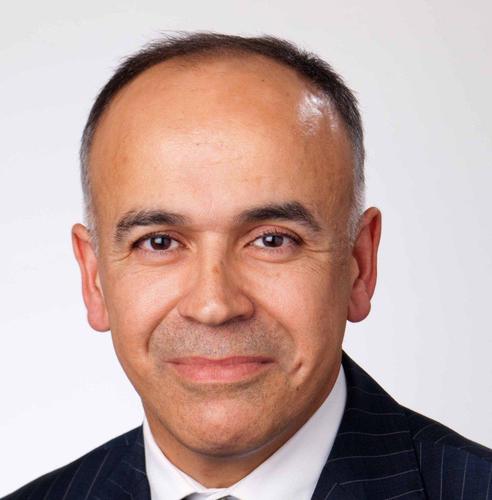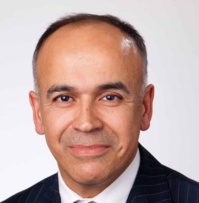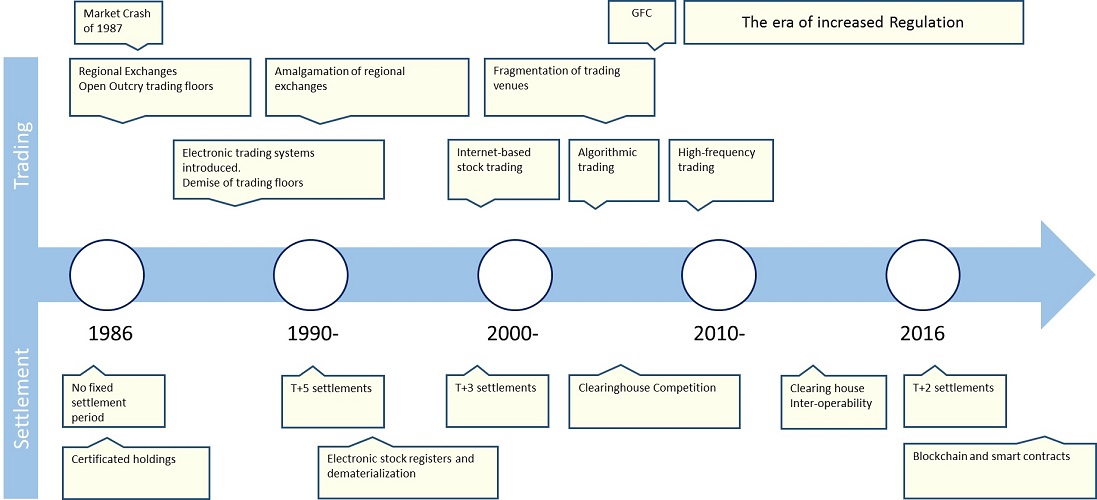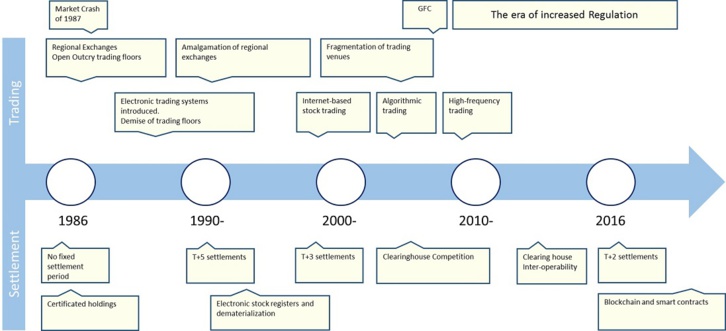Arguably the most important blockchain technology, as it applies to capital markets, is distributed ledger technology (DLT), which could potentially remove many of the inefficiencies and costs inherent in today’s market infrastructure.
However, despite the potential of DLT, challenges remain, many of which are business- rather than technology-related. From looking at major changes in markets infrastructure over the past 30 years, we have attempted to predict what DLT may deliver in the future.
However, despite the potential of DLT, challenges remain, many of which are business- rather than technology-related. From looking at major changes in markets infrastructure over the past 30 years, we have attempted to predict what DLT may deliver in the future.
How much of what we do is based on the legacy of paper?
Thirty years ago, equities markets were largely paper-based via tickets, certificates and ledgers. It took five days or more to settle trades, mainly because paper had to physically move between counterparties. Today many of these processes have been digitised, trading has been able to capitalise on digitalisation to a much greater extent than clearing and settlement which largely replicates the paper-based processes. This has left three major inefficiencies: the need to reconcile books and records between participants, the need for centralised providers to manage risk and facilitate communications, and the two to three-day delay between trade day and settlement day.
Can DLT solve these inefficiencies?
Ultimately the problem with the current market infrastructure is cost, which can be broken down into the cost to transact and the cost of maintaining capital and covering risk.
Capital is required to cover risk – counterparty risk, principal risk and others, which carries a cost. This includes the cost to the market of requiring a central counterparty to manage risk. Reducing the settlement timeframe to trade day or even in real-time will reduce this risk. DLT is seen as a viable technology to enable T0 settlement.
The cost to transact includes the cost of depositories to keep records of ownership, intermediaries and multiple back offices, interconnected by complex electronic messaging protocols, but each with their own version of the truth. Reduce the need for trusted intermediaries and reduce reconciliation costs, and transaction cost will come down.
The question is whether DLT can reduce these costs and how much of the cost reduction is dependent on business rule changes rather than the introduction of technology. DLT will only succeed with whole-sale changes in market practice as proposed in the scenarios in this paper.
What is needed to succeed?
For DLT to be useful in reducing costs, it must meet all of the requirements capital markets generally seek:
- Settlement finality
- Traceability
- Anonymity at the appropriate points
- Low latency
- Scalability
- Liquidity
- Richness of information – metadata
Otherwise it risks reducing the efficiency and utility of current markets.
In some cases, particularly where there is a high level of regulation and mature market infrastructure, DLT is more likely to form part of a new architecture, rather than form the full replacement of the existing architecture. We posed four possible scenarios for the introduction of DLT into capital markets clearing and settlement with differing impacts on the operations of capital markets participants.
1. Technology Replacement
Represents a limited-disruption introduction of the technology by incumbent market operators. From a technology perspective, this is the simplest scenario to achieve because it can be implemented fastest with few if any market structure changes. From a commercial perspective, it provides the least cost savings to the market and as such can be seen as a stepping stone for further evolution.
2. The Extensible Ledger
Technology replacement is extended to provide an extensible ‘Smart Ledger’. This scenario could also be delivered by an industry association of participants. Creating a truly open and collaborative platform for key capital market infrastructure while meeting all applicable regulatory and legal concerns is a significant challenge and appears unlikely to be achievable in the short term.
3. A new Global C&S Infrastructure
A global consortium of brokers, banks and C&S providers collaborate on a next-generation distributed ledger-based C&S platform. This scenario is already being considered via the R3 consortium. However, it is highly likely that this scenario will take many years to bring to fruition and will only be introduced in phases.
4. Uber Finance
DLT creates a truly global peer-to-peer network which is capable of replacing the traditional capital markets systems. Several technology platforms capable of providing this service already exist in some form, or are in the process of development, but it is unclear if any of them will prove to be any sort of challenge to traditional market infrastructures. As we have seen with other peer-to-peer technologies such as BitCoin and Uber, a level of interoperability with applicable regulatory frameworks is key to moving toward mainstream adoption.
Rob DeDominicis
Robert was appointed to Chief Executive Officer and Managing Director in December 2015. He is a founding partner of InfoComp, now GBST’s Wealth Management Division, with over 25 years experience in the development of software applications. Robert holds a Bachelor of Mathematics. Robert has a business and technical software background having been part of the Wealth Management Division’s development and professional services teams.
www.gbst.com
Thirty years ago, equities markets were largely paper-based via tickets, certificates and ledgers. It took five days or more to settle trades, mainly because paper had to physically move between counterparties. Today many of these processes have been digitised, trading has been able to capitalise on digitalisation to a much greater extent than clearing and settlement which largely replicates the paper-based processes. This has left three major inefficiencies: the need to reconcile books and records between participants, the need for centralised providers to manage risk and facilitate communications, and the two to three-day delay between trade day and settlement day.
Can DLT solve these inefficiencies?
Ultimately the problem with the current market infrastructure is cost, which can be broken down into the cost to transact and the cost of maintaining capital and covering risk.
Capital is required to cover risk – counterparty risk, principal risk and others, which carries a cost. This includes the cost to the market of requiring a central counterparty to manage risk. Reducing the settlement timeframe to trade day or even in real-time will reduce this risk. DLT is seen as a viable technology to enable T0 settlement.
The cost to transact includes the cost of depositories to keep records of ownership, intermediaries and multiple back offices, interconnected by complex electronic messaging protocols, but each with their own version of the truth. Reduce the need for trusted intermediaries and reduce reconciliation costs, and transaction cost will come down.
The question is whether DLT can reduce these costs and how much of the cost reduction is dependent on business rule changes rather than the introduction of technology. DLT will only succeed with whole-sale changes in market practice as proposed in the scenarios in this paper.
What is needed to succeed?
For DLT to be useful in reducing costs, it must meet all of the requirements capital markets generally seek:
- Settlement finality
- Traceability
- Anonymity at the appropriate points
- Low latency
- Scalability
- Liquidity
- Richness of information – metadata
Otherwise it risks reducing the efficiency and utility of current markets.
In some cases, particularly where there is a high level of regulation and mature market infrastructure, DLT is more likely to form part of a new architecture, rather than form the full replacement of the existing architecture. We posed four possible scenarios for the introduction of DLT into capital markets clearing and settlement with differing impacts on the operations of capital markets participants.
1. Technology Replacement
Represents a limited-disruption introduction of the technology by incumbent market operators. From a technology perspective, this is the simplest scenario to achieve because it can be implemented fastest with few if any market structure changes. From a commercial perspective, it provides the least cost savings to the market and as such can be seen as a stepping stone for further evolution.
2. The Extensible Ledger
Technology replacement is extended to provide an extensible ‘Smart Ledger’. This scenario could also be delivered by an industry association of participants. Creating a truly open and collaborative platform for key capital market infrastructure while meeting all applicable regulatory and legal concerns is a significant challenge and appears unlikely to be achievable in the short term.
3. A new Global C&S Infrastructure
A global consortium of brokers, banks and C&S providers collaborate on a next-generation distributed ledger-based C&S platform. This scenario is already being considered via the R3 consortium. However, it is highly likely that this scenario will take many years to bring to fruition and will only be introduced in phases.
4. Uber Finance
DLT creates a truly global peer-to-peer network which is capable of replacing the traditional capital markets systems. Several technology platforms capable of providing this service already exist in some form, or are in the process of development, but it is unclear if any of them will prove to be any sort of challenge to traditional market infrastructures. As we have seen with other peer-to-peer technologies such as BitCoin and Uber, a level of interoperability with applicable regulatory frameworks is key to moving toward mainstream adoption.
Rob DeDominicis
Robert was appointed to Chief Executive Officer and Managing Director in December 2015. He is a founding partner of InfoComp, now GBST’s Wealth Management Division, with over 25 years experience in the development of software applications. Robert holds a Bachelor of Mathematics. Robert has a business and technical software background having been part of the Wealth Management Division’s development and professional services teams.
www.gbst.com
Retrouvez tous les articles dédiés blockchain & distributed ledger technology dans votre nouveau quotidien Blockchain Daily News
Participez aux prochaines conférences Blockchain éditées par Finyear Group :
Blockchain Vision #5 + Blockchain Pitch Day #2 (20 septembre 2016)
Blockchain Hackathon #1 (fin 2016).
Participez aux prochaines conférences Blockchain éditées par Finyear Group :
Blockchain Vision #5 + Blockchain Pitch Day #2 (20 septembre 2016)
Blockchain Hackathon #1 (fin 2016).
Les médias du groupe Finyear
Lisez gratuitement :
Le quotidien Finyear :
- Finyear Quotidien
La newsletter quotidienne :
- Finyear Newsletter
Recevez chaque matin par mail la newsletter Finyear, une sélection quotidienne des meilleures infos et expertises en Finance innovation, Blockchain révolution & Digital transformation.
Les 6 lettres mensuelles digitales :
- Le Directeur Financier
- Le Trésorier
- Le Credit Manager
- The Chief FinTech Officer
- The Chief Blockchain Officer
- The Chief Digital Officer
Le magazine trimestriel digital :
- Finyear Magazine
Un seul formulaire d'abonnement pour recevoir un avis de publication pour une ou plusieurs lettres
Le quotidien Finyear :
- Finyear Quotidien
La newsletter quotidienne :
- Finyear Newsletter
Recevez chaque matin par mail la newsletter Finyear, une sélection quotidienne des meilleures infos et expertises en Finance innovation, Blockchain révolution & Digital transformation.
Les 6 lettres mensuelles digitales :
- Le Directeur Financier
- Le Trésorier
- Le Credit Manager
- The Chief FinTech Officer
- The Chief Blockchain Officer
- The Chief Digital Officer
Le magazine trimestriel digital :
- Finyear Magazine
Un seul formulaire d'abonnement pour recevoir un avis de publication pour une ou plusieurs lettres








